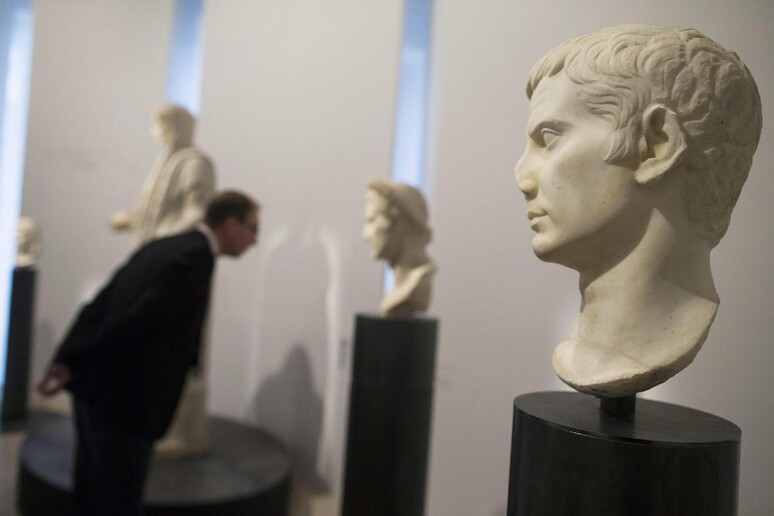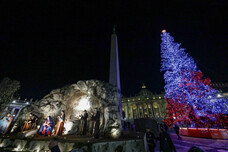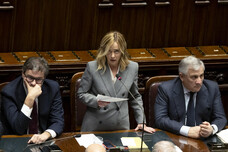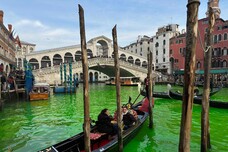(By Christopher Livesay)
The critically acclaimed
exhibition on Roman Emperor Augustus that recently closed in
Rome will soon make its way to the French capital's Grand Palais
as part of celebrations for the 2,000th anniversary of his death
on August 19 in 14 AD.
An extra 100 works and a new exhibition route will be added
to the exhibition 'Moi, Auguste, Empereur de Rome', which opens
Wednesday and runs through July 13.
Titled simply 'Augustus' during its Rome debut, the
sweeping exhibition records the career of Julius Caesar's
adopted son who became Rome's leader after defeating Mark Antony
and Cleopatra, the "skilful marketing" he used to secure his
place in posterity and the legitimacy of a form of rule reviled
by Roman tradition.
It illustrates his huge PR successes: the rich literary
world he forged with poets such as Virgil and Horace, the mythic
aura he projected with huge-scale statuary work, the celebration
of peace and prosperity he brought to an empire roiled by 50
years of bloody infighting, and his well-publicised efforts to
secure his legacy with a succession of anointed heirs before the
throne passed to the last one standing, Tiberius.
Loans include a veiled statue of Augustus as pontifex
maximus, from Rome's Palazzo Massimo; a Hermes-like statue of
the first and favourite heir-apparent Marcellus, his nephew,
from the Louvre; a marble portrait of Marcellus from the private
Sorgente Foundation; a female wild-boar relief from Palestrina
east of Rome; a marble votive shield from Arles in France; a
head of Ulysses - from whose Trojan foes Augustus claimed
inheritance - from Sperlonga south of Rome; and the famous
Blacas cameo from the British Museum.
The show is the brainchild of former superintendent Eugenio
La Rocca, who curated it with the assistance of Claudio Parisi
Presicce and Annalisa Lo Monaco, in close collaboration with the
French curators of the Louvre museum, Cecile Giroire and Daniel
Roger.
It includes 357 works, with exceptional loans from some of
the world's most important museums.
The exhibition shows the unstoppable rise of Augustus: the
principality years, the reforms of crucial importance for the
centuries to come, and the emergence of new aesthetics and
imperial iconography.
There are statues, portraits, and home furnishings in
bronze, silver and glass, gold and jewels.
One of the centerpieces is a bronze equestrian statue from
the Athens Museum, a portrait from the British Museum, the busts
of Augustus and his numerous relatives, his wife Livia, and
sister Octavia, as well as reliefs and decorative art pieces.
"This is a joint project between the Azienda Speciale
Palaexpo, Scuderie del Quirinale and Musei Capitolini di Roma,
in collaboration with the Reunion des Musees Nationaux, il Grand
Palais and the Louvre," Cecile Giroire, from the Louvre's Greek,
Etruscan and Roman Antiquities Department, told ANSA.
"The list of the works from Rome and Paris is more or less
the same, and the most important loans have been kept, but in
the French capital we went on to develop some additional
aspects".
There is a section on Rome in the era of Augustus with the
urban development of the city, as well as a larger one on the
provinces, with the integration of a Gaul represented by
funerary decorations, trophies and portraits.
"In Paris we have about a hundred more works," Giroire
said, "that are for the two new sections and to complete the
sections presented in Rome".
The curators go on to say: "Where even Julius Caesar had
failed, Augustus succeeded in putting an end to the decades of
internecine strife that had brought the Roman Republic to its
knees, and in inaugurating a new political era: the Empire.
"His reign, which lasted over 40 years, was to be the
longest in the city's entire history.
"Under Augustus the Empire achieved its greatest expansion,
spreading to cover the whole of the Mediterranean basin, from
Spain to Turkey and from the Maghreb to Greece, and Germany.
"The details of his life and dazzling career are known to
us both from the emperor himself and from historians as Velleius
Paterculus, Suetonius, Tacitus and Cassius Dio.
"In fact there are very few other Roman emperors for whose
life we have such a large number of written sources.
"This allows us to reconstruct the stages of a political
career in the course of which Augustus held all of the most
important public offices, and at the same time to track the
disastrous series of deaths in his family that robbed him, in
the space of a few decades, both of Agrippa, his son-in-law and
deputy, and of the heirs designated to succeed him: his nephew
Marcellus, the son of his sister Octavia, and Gaius and Lucius
Caesar, the sons of Julia and Agrippa.
"Thus on his death the Empire passed into the hands of
Tiberius, the son of his third and much-loved wife Livia.
"The end of civil strife was skilfully marketed as an era
of peace, prosperity and abundance.
"It was then that such crucial concepts as pax, pietas and
concordia began to circulate, sung by poets of the calibre of
Virgil, Horace and the entire coterie of intellectuals gathered
around (aristocratic patron) Maecenas.
"The exhibition will...offer visitors the chance to explore
the emperor's life and career, which coincided with the birth of
a new artistic culture and language that continues even today to
lie at the very root of Western civilisation".
ALL RIGHTS RESERVED © Copyright ANSA











